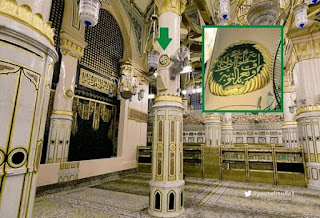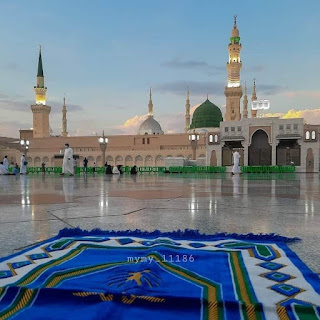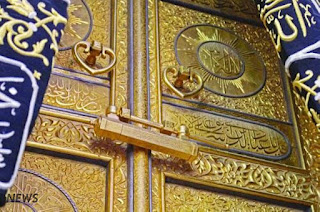събота, 18 декември 2021 г.
A view of the basement of Masjid al-Haram
Basement of Masjid al-Haram, Makkah
петък, 8 октомври 2021 г.
The Miqat area, names of the Miqats and their distance from Makkah
The Miqat area, names of the Miqats and their distance from Makkah
The Miqat boundary is where pilgrims intending to perform Hajj or Umrah pilgrimage must enter the state of ihram before crossing into.
This involves performing ritual cleaning and wearing prescribed clothing.
The Dhul Hulaifah Miqat
The Dhul Hulaifah Miqat
It's located around 10km south-west from Masjid-e-Nabwi
It serves as the Miqat for those who live in Madinah and for those who approach Makkah from that direction.
The Dhat Irq Miqat
The Dhat Irq Miqat
It's located 94km north-east from Makkah, serving as the Miqat for the people of Iraq, Iran and those travelling to Makkah from that general direction.
It was established during the Caliphate of Umar (رضي الله عنه), after Basra and Kufa were conquered.
The Qarn al-Manazil Miqat
The Qarn al-Manazil Miqat
It's located 75km east of Makkah,
This is the Miqat for the people of Najd and those coming from Taif and Riyadh.
The Yalamlam Miqat
The Yalamlam Miqat
It's located 92 km south of Makkah.
In the past it was used by people from the Indian sub-continent who would travel by ship.
The Al-Johfa Miqat
The Al-Johfa Miqat
It's located around 183km north-west of Makkah.
It serves as the Miqat for the people who come from the direction of Syria, Egypt, Turkey and other countries from that region.
The resting place of Haleemah Sa’diya
The resting place of Haleemah Sa’diya
She was the wet-nurse of the Prophet (ﷺ).
It's located in the Jannatul Baqi graveyard in Madinah.
The location of the 'Bir Ha' well in Masjid-e-Nabwi
The location of the 'Bir Ha' well in Masjid-e-Nabwi
This circle, in the rear of Masjid-e-Nabwi, marks the spot where a well existed during the time of the Prophet (ﷺ).
The well, known as 'Bir Ha', was owned by the sahabi Abu Talha (رضي الله عنه). The Prophet (ﷺ) often visited his garden and drank the water from this well.
Viewing hole at the front of Masjid-e-Nabwi in Madinah
Viewing hole at the front of Masjid-e-Nabwi in Madinah
This viewing hole directly faces the noble face of the Prophet Muhammad (ﷺ) who is resting within the Sacred Chamber inside.
събота, 18 септември 2021 г.
meka
WHEN Malcolm X visited Mecca in 1964, he was enchanted. He found the city “as ancient as time itself,” and wrote that the partly constructed extension to the Sacred Mosque “will surpass the architectural beauty of India’s Taj Mahal.”
Fifty years on, no one could possibly describe Mecca as ancient, or associate beauty with Islam’s holiest city. Pilgrims performing the hajj this week will search in vain for Mecca’s history.
The dominant architectural site in the city is not the Sacred Mosque, where the Kaaba, the symbolic focus of Muslims everywhere, is. It is the obnoxious Makkah Royal Clock Tower hotel, which, at 1,972 feet, is among the world’s tallest buildings. It is part of a mammoth development of skyscrapers that includes luxury shopping malls and hotels catering to the superrich. The skyline is no longer dominated by the rugged outline of encircling peaks. Ancient mountains have been flattened. The city is now surrounded by the brutalism of rectangular steel and concrete structures — an amalgam of Disneyland and Las Vegas.
The “guardians” of the Holy City, the rulers of Saudi Arabia and the clerics, have a deep hatred of history. They want everything to look brand-new. Meanwhile, the sites are expanding to accommodate the rising number of pilgrims, up to almost three million today from 200,000 in the 1960s.
MICHELA BUTTIGNOL
The initial phase of Mecca’s destruction began in the mid-1970s, and I was there to witness it. Innumerable ancient buildings, including the Bilal mosque, dating from the time of the Prophet Muhammad, were bulldozed. The old Ottoman houses, with their elegant mashrabiyas — latticework windows — and elaborately carved doors, were replaced with hideous modern ones. Within a few years, Mecca was transformed into a “modern” city with large multilane roads, spaghetti junctions, gaudy hotels and shopping malls.
The few remaining buildings and sites of religious and cultural significance were erased more recently. The Makkah Royal Clock Tower, completed in 2012, was built on the graves of an estimated 400 sites of cultural and historical significance, including the city’s few remaining millennium-old buildings. Bulldozers arrived in the middle of the night, displacing families that had lived there for centuries. The complex stands on top of Ajyad Fortress, built around 1780, to protect Mecca from bandits and invaders. The house of Khadijah, the first wife of the Prophet Muhammad, has been turned into a block of toilets. The Makkah Hilton is built over the house of Abu Bakr, the closest companion of the prophet and the first caliph.
Apart from the Kaaba itself, only the inner core of the Sacred Mosque retains a fragment of history. It consists of intricately carved marble columns, adorned with calligraphy of the names of the prophet’s companions. Built by a succession of Ottoman sultans, the columns date from the early 16th century. And yet plans are afoot to demolish them, along with the whole of the interior of the Sacred Mosque, and to replace it with an ultramodern doughnut-shaped building.
The only other building of religious significance in the city is the house where the Prophet Muhammad lived. During most of the Saudi era it was used first as a cattle market, then turned into a library, which is not open to the people. But even this is too much for the radical Saudi clerics who have repeatedly called for its demolition. The clerics fear that, once inside, pilgrims would pray to the prophet, rather than to God — an unpardonable sin. It is only a matter of time before it is razed and turned, probably, into a parking lot.
Slide Show | Mecca Over the Years A changing view of Islam’s holiest city.
The cultural devastation of Mecca has radically transformed the city. Unlike Baghdad, Damascus and Cairo, Mecca was never a great intellectual and cultural center of Islam. But it was always a pluralistic city where debate among different Muslim sects and schools of thought was not unusual. Now it has been reduced to a monolithic religious entity where only one, ahistoric, literal interpretation of Islam is permitted, and where all other sects, outside of the Salafist brand of Saudi Islam, are regarded as false. Indeed, zealots frequently threaten pilgrims of different sects. Last year, a group of Shiite pilgrims from Michigan were attacked with knives by extremists, and in August, a coalition of American Muslim groups wrote to the State Department asking for protection during this year’s hajj.
The erasure of Meccan history has had a tremendous impact on the hajj itself. The word “hajj” means effort. It is through the effort of traveling to Mecca, walking from one ritual site to another, finding and engaging with people from different cultures and sects, and soaking in the history of Islam that the pilgrims acquired knowledge as well as spiritual fulfillment. Today, hajj is a packaged tour, where you move, tied to your group, from hotel to hote






































































































